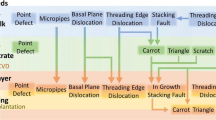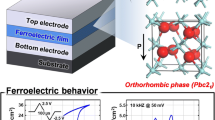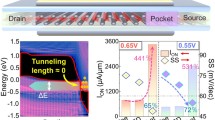Abstract
The charge-trapping process, with HfO2 film as the charge-capturing layer, has been investigated by using in situ electron energy-loss spectroscopy and in situ energy-filter image under positive external bias. The results show that oxygen vacancies are non-uniformly distributed throughout the HfO2 trapping layer during the programming process. The distribution of the oxygen vacancies is not the same as that of the reported locations of the trapped electrons, implying that the trapping process is more complex. These bias-induced oxygen defects may affect the device performance characteristics such as the device lifetime. This phenomenon should be considered in the models of trapping processes.

Similar content being viewed by others
References
Wegener, H. A. R.; Lincoln, A. J.; Pao, H. C.; O’Connell, M. R.; Oleksiak, R. E.; Lawrence, H. The variable threshold transistor, a new electrically-alterable, non-destructive readonly storage device. In 1967 International Electron Devices Meeting, Washington,DC,USA, 1967, pp 70.
Yao, Y.; Li, C.; Huo, Z. L.; Liu, M.; Zhu, C. X.; Gu, C. Z.; Duan, X. F.; Wang, Y. G.; Gu, L.; Yu, R. C. In situ electron holography study of charge distribution in high-κ chargetrapping memory. Nat. Commun. 2013, 4, 2764.
Xiong, K.; Robertson, J.; Gibson, M. C.; Clark, S. J. Defect energy levels in HfO2 high-dielectric-constant gate oxide. Appl. Phys. Lett. 2005, 87, 183505.
Shockley, W.; Read, W. T. Statistics of the recombinations of holes and electrons. Phys. Rev. 1952, 87, 835–842.
Park, H.; Jo, M.; Choi, H.; Hasan, M.; Choi, R.; Kirsch, P. D.; Kang, C. Y.; Lee, B. H.; Kim, T. W.; Lee, T. et al. The effect of nanoscale nonuniformity of oxygen vacancy on electrical and reliability characteristics of HfO2 MOSFET devices. IEEE Electr. Dev. Lett. 2008, 29, 54–56.
Sahoo, S. K.; Misra, D. Interfacial layer growth condition dependent carrier transport mechanisms in HfO2/SiO2 gate stacks. Appl. Phys. Lett. 2012, 100, 232903.
Choi, E. A.; Chang, K. J. Charge-transition levels of oxygen vacancy as the origin of device instability in HfO2 gate stacks through quasiparticle energy calculations. Appl. Phys. Lett. 2009, 94, 122901.
Gavartin, J. L.; Ramo, D. M.; Shluger, A. L.; Bersuker, G.; Lee, B. H. Negative oxygen vacancies in HfO2 as charge traps in high-κ stacks. Appl. Phys. Lett. 2006, 89, 082908.
Cho, D. Y.; Lee, Y. J. M.; Oh, S. J.; Jang, H.; Kim, J. Y.; Park, J. H.; Tanaka, A. Influence of oxygen vacancies on the electronic structure of HfO2 films. Phys. Rev. B 2007, 76, 165411.
Perevalov, T. V.; Aliev, V. Sh.; Gritsenko, V. A.; Saraev, A. A.; Kaichev, V. V. Electronic structure of oxygen vacancies in hafnium oxide. Microelectron. Eng. 2013, 109, 21–23.
Zhang, W.; Hou, Z. F. Interaction and electronic structures of oxygen divacancy in HfO2. Phys. Stat. Sol. (b) 2013, 250, 352–355.
Pandey, R. K.; Sathiyanarayanan, R.; Kwon, U.; Narayanan, V; Murali, K. V. R. M. Role of point defects and HfO2/TiN interface stoichiometry on effective work function modulation in ultra-scaled complementary metal-oxide-semiconductor devices. J. Appl. Phys. 2013, 114, 034505.
Jang, J. H.; Jung, H. S.; Kim, J. H.; Lee, S. Y.; Hwang, C. S.; Kim, M. Investigation of oxygen-related defects and the electrical properties of atomic layer deposited HfO2 films using electron energy-loss spectroscopy. J. Appl. Phys. 2011, 109, 023718.
Jo, M.; Park, H.; Chang, M.; Jung, H. S.; Lee, J. H.; Hwang, H. Oxygen vacancy induced charge trapping and positive bias temperature instability in HfO2 nMOSFET. Microelectron. Eng. 2007, 84, 1934–1937.
Broqvist, P.; Pasquarello, A. Oxygen vacancy in monoclinic HfO2: A consistent interpretation of trap assisted conduction, direct electron injection, and optical absorption experiments. Appl. Phys. Lett. 2006, 89, 262904.
Bersuker, G.; Gilmer, D. C.; Veksler, D.; Kirsch, P.; Vandelli, L.; Padovani, A.; Larcher, L.; McKenna, K.; Shluger, A.; Iglesias, V. et al. Metal oxide resistive memory switching mechanism based on conductive filament properties. J. Appl. Phys. 2011, 110, 124518.
Yu, S. M.; Gao, B.; Dai, H. B.; Sun, B.; Liu, L. F.; Liu, X. Y.; Han, R. Q.; Kang, J. F.; Yu, B. Improved uniformity of resistive switching behaviors in HfO2 thin films with embedded Al layers. Electrochem. Solid-St. Lett. 2010, 13, H36–H38.
Tran, X. A.; Zhu, W.; Liu, W. J.; Yeo, Y. C.; Nguyen, B. Y.; Yu, H. Y. Self-selection unipolar HfOx-based RRAM. IEEE Trans. Electr. Dev. 2013, 60, 391–395.
Chen, Y. Y.; Goux, L.; Clima, S.; Govoreanu, B.; Degraeve, R.; Kar, G. S.; Fantini, A.; Groeseneken, G.; Wouters, D. J.; Jurczak, M. Endurance/retention trade-off on cap 1T1R bipolar RRAM. IEEE Trans. Electr. Dev. 2013, 60, 1114–1121.
Lin, Y. S.; Zeng, F.; Tang, S. G.; Liu, H. Y.; Chen, C.; Gao, S.; Wang, Y. G.; Pan, F. Resistive switching mechanisms relating to oxygen vacancies migration in both interfaces in Ti/HfOx/Pt memory devices. J. Appl. Phys. 2013, 113, 064510.
Zhang, H. W.; Liu, L. F.; Gao, B.; Qiu, Y. J.; Liu, X. Y.; Lu, J.; Han, R.; Kang, J. F.; Yu, B. Gd-doping effect on performance of HfO2 based resistive switching memory devices using implantation approach. Appl. Phys. Lett. 2011, 98, 042105.
Lee, J.; Bourim, E. M.; Lee, W.; Park, J.; Jo, M.; Jung, S.; Shin, J.; Hwang, H. Effect of ZrOx/HfOx bilayer structure on switching uniformity and reliability in nonvolatile memory applications. Appl. Phys. Lett. 2010, 97, 172105.
Yang, Y.; Lü, W. M.; Yao, Y.; Sun, J. R.; Gu, C. Z.; Gu, L.; Wang, Y. G.; Duan, X. F.; Yu, R. C. In situ TEM observation of resistance switching in titanate based device. Sci. Rep. 2013, 4, 3890.
Kwon, D. H.; Kim, K. M.; Jang, J. H.; Jeon, J. M.; Lee, M. H.; Kim, G. H.; Li, X. S.; Park, G. S.; Lee, B.; Han, S. et al. Atomic structure of conducting nanofilaments in TiO2 resistive switching memory. Nat. Nanotechnol. 2010, 5, 148–153.
Park, G. S.; Kim, Y. B.; Park, S. Y.; Li, X. S.; Heo, S.; Lee, M. J.; Chang, M.; Kwon, J. H.; Kim, M.; Chung, U. I. et al. In situ observation of filamentary conducting channels in an asymmetric Ta2O5-x /TaO2-x bilayer structure. Nat. Commun. 2013, 4, 2382.
Liu, Q.; Sun, J.; Lv, H. B.; Long, S. B.; Yin, K. B.; Wan, N.; Li, Y. T.; Sun, L. T.; Liu, M. Real-time observation on dynamic growth/dissolution of conductive filaments in oxideelectrolyte- based ReRAM. Adv. Mater. 2012, 24, 1844–1849.
Guedj, C.; Hung, L.; Zobelli, A.; Blaise, P.; Sottile, F.; Olevano, V. Evidence for anisotropic dielectric properties of monoclinic hafnia using valence electron energy-loss spectroscopy in high-resolution transmission electron microscopy and ab initio time-dependent density-functional theory. Appl. Phys. Lett. 2014, 105, 222904.
Park, J.; Yang, M. Determination of complex dielectric functions at HfO2/Si interface by using STEM-VEELS. Micron 2009, 40, 365–369.
Kang, Y. S.; Kim, D. K.; Kang, H. K.; Cho, S.; Choi, S.; Kim, H.; Seo, J. H.; Lee, J.; Cho, M. H. Defect states below the conduction band edge of HfO2 grown on InP by atomic layer deposition. J. Phys. Chem. C 2015, 119, 6001–6008.
Sawa, A. Resistive switching in transition metal oxides. Mater. Today 2008, 11, 28–36.
Bersuker, G.; Yum, J.; Vandelli, L.; Padovani, A.; Larcher, L.; Iglesias, V.; Porti, M.; Nafría, M.; McKenna, K.; Shluger A. et al. Grain boundary-driven leakage path formation in HfO2 dielectrics. Solid-State Electron. 2011, 65–66, 146–150.
Lanza, M. A review on resistive switching in high-κ dielectrics: A nanoscale point of view using conductive atomic force microscope. Materials 2014, 7, 2155–2182.
Broqvist, P.; Pasquarello, A. First principles investigation of defects at interfaces between silicon and amorphous high-κ oxides. Microelectron. Eng. 2007, 84, 2022–2027.
Zhang, T.; Ou, X.; Zhang, W. F.; Yin, J.; Xia, Y. D.; Liu, Z. G. High-κ-rare-earth-oxide Eu2O3 films for transparent resistive random access memory (RRAM) devices. J. Phys. D: Appl. Phys. 2014, 47, 065302.
Lyons, J. L.; Janotti, A.; Van de Walle, C. G. The role of oxygen-related defects and hydrogen impurities in HfO2 and ZrO2. Microelectron. Eng. 2011, 88, 1452–1456.
Mao, L. F.; Wang, Z. O. First-principles simulations of the leakage current in metal-oxide-semiconductor structures caused by oxygen vacancies in HfO2 high-κ gate dielectric. Phys. Stat. Sol. (a) 2008, 205, 199–203.
Nadimi, E.; Roll, G.; Kupke, S.; Öttking, R.; Plänitz, P.; Radehaus, C.; Schreiber, M.; Agaiby, R.; Trentzsch, M.; Knebel, S. et al. The degradation process of high-κ SiO2/HfO2 gate-stacks: A combined experimental and first principles investigation. IEEE Trans. Electr. Dev. 2014, 61, 1278–1283.
Perevalov, T. V.; Gritsenko, V. A. Application and electronic structure of high-permittivity dielectrics. In Proceedings of the 2010 27th International Conference on Microelectronics Proceedings, Nis, Serbia, 2010, pp 123–126.
Padovani, A.; Larcher, L.; Bersuker, G.; Pavan, P. Charge transport and degradation in HfO2 and HfOx dielectrics. IEEE Electr. Dev. Lett. 2013, 34, 680–682.
Mao, L. F.; Wang, Z. O.; Wang, J. Y.; Zhu, C. Y. The conduction band alignment of HfO2 caused by oxygen vacancies and its effects on the gate leakage current in MOS structures. Eur. Phys. J. Appl. Phys. 2007, 40, 59–63.
Mannequin, C.; Gonon, P.; Vallée, C.; Latu-Romain, L.; Bsiesy, A.; Grampeix, H.; Salaün, A.; Jousseaume, V. Stressinduced leakage current and trap generation in HfO2 thin films. J. Appl. Phys. 2012, 112, 074103.
Egerton, R. F. Electron Energy-Loss Spectroscopy in the Electron Microscope; Springer: New York, USA, 1995.
Author information
Authors and Affiliations
Corresponding authors
Additional information
These authors contributed equally to this work.
Electronic supplementary material
Rights and permissions
About this article
Cite this article
Li, C., Yao, Y., Shen, X. et al. Dynamic observation of oxygen vacancies in hafnia layer by in situ transmission electron microscopy. Nano Res. 8, 3571–3579 (2015). https://doi.org/10.1007/s12274-015-0857-0
Received:
Revised:
Accepted:
Published:
Issue Date:
DOI: https://doi.org/10.1007/s12274-015-0857-0




